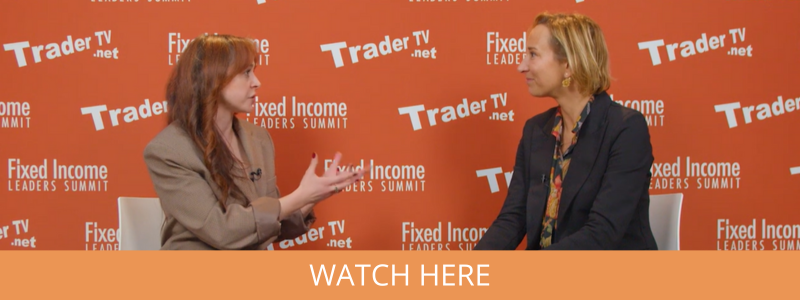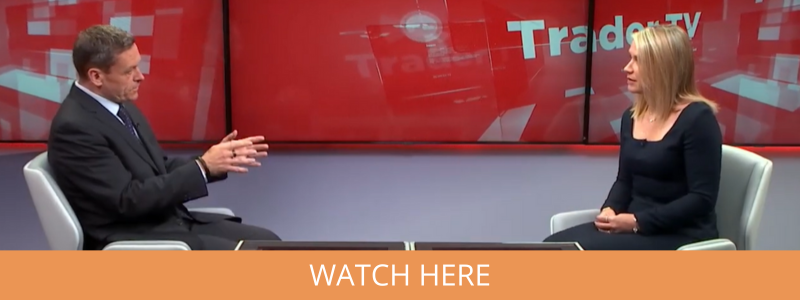Fixed Income Leaders 2026 Blog
FILS EU 2025 - Live interview to Charlotte Alliot [Euronext]

At the Fixed Income Leaders Summit 2025, Charlotte Alliot at Euronext shares how the exchange is reshaping access to fixed income derivatives for both retail and buy-side investors.
Key highlights:
- Launch of Europe’s first mini futures on government bonds
- New contracts on the Bund, Bono, BTP — including the first-ever 30-year BTP future
- Products co-designed with the trading community
- Strong early adoption with balanced retail + market-maker participation
- Easy-to-use, cash-settled contracts offering more flexibility and granularity.
Watch the full interview to hear Charlotte’s insights.
TransFICC at FILS Europe 2025 – The Future of Bond Trading

🎬 Recorded live at Fixed Income Leaders Summit Europe 2025! Steve Toland, Founder of TransFICC, sat down with Trader TV’s Joe Gallagher to talk about the future of bond trading tech.
From faster price quoting and managing massive data volumes - up to 30,000 price updates every second - to enabling portfolio trading across multiple venues, Steve shares how TransFICC is pushing the boundaries of what’s possible. He also talks about the new investment from Citadel Securities and how it’s powering innovation in liquidity access and automation across global fixed income markets.
👉 Watch the video to hear how TransFICC is transforming bond trading technology.
J.P. Morgan’s Kate Finlayson on Fixed-Income Market Structure 2025

How are regulation, transparency and technology transforming fixed income trading in 2025?
🎥 Watch the full interview now to hear expert insights from Kate Finlayson, Head of FICC Market Structure & Liquidity Strategy at J.P. Morgan, in conversation with TraderTV. Kate explores the forces reshaping global markets - from evolving regulation to new trading technologies - and what they mean for liquidity and execution strategy.
Don’t miss this forward-looking conversation on how regulation and innovation are redefining the future of fixed income trading. 👉 Watch the interview for expert insights into global liquidity and execution strategy.
JP Morgan: Shifting trading trends are driving growth in credit ETFs

Matt Legg, managing director, at JP Morgan Chase & Co, speaks to Trader TV about where he sees growth in credit exchange-traded funds (ETFs) and the drivers behind this momentum. He says that buy-side adoption of portfolio trading is playing a role in fuelling demand for ETFs and improving overall liquidity conditions in the space.
As an ETF market maker, Legg unpacks how intermediaries like JP Morgan can better support their buy-side counterparts, through efficient pricing and managing risks.
And looking ahead, the JP Morgan executive discusses what’s next for credit ETFs and whether this growth, he’s seeing in passive investments, can be translated to the active space.
JP Morgan sees surging appetite for portfolio trading and diversification

Olivier Cajfinger, managing director at JP Morgan, spoke to Trader TV at this year’s Fixed Income Leaders’ Summit in Paris about emerging trends in portfolio trading and where he sees growing demand for PT and diversification of execution tools.
The MD discusses the momentum behind this growing appetite for customized solutions, tool selection, the wider impact of exchanged traded funds on portfolio trading, and the developing interest in illiquid credit markets.
In response to these trends, Caj also unpacks how the dealer is adapting its line of services to better manage and recycle risk and deliver customized, corporate bond pricing information via its tool Vida Portfolio Solutions.
JP Morgan: Third-party fees are fuelling the demand for direct connectivity

Hannah Baum, head of FICC E-commerce and sales for Europe, the Middle East, and Africa, at JP Morgan tells Trader TV that growing third-party platform fees and margin compression across the buy side are fuelling greater demand for direct connectivity to dealers.
The sales head says there are various ways in which asset managers can circumvent these increasing costs by using application programming interfaces (APIs) for streaming prices, and axes, and trading directly with the sell side.
Baum additionally unpacks what this direct connectivity also means for dealers, their bottom line and their relationships with the buy side.
Industry participants push for standardisation in primary markets

Primary markets inefficiencies in fixed income create major operational risks and costs to buy-side and syndicate desks. Yet, many market participants are generating momentum to resolve these legacy-laden problems.
Trader TV speaks to James Frew, co-head of fixed income trading, at Pictet Asset Management, Mike Poole, head of trading, at Jupiter Asset Management, and Olivier Dermeux, executive director of fixed income strategy at S&P Global Market Intelligence about how this space can progress and how standardisation and industry collaboration need to become core components of that evolution.
Dermeux discusses what industry collaboration could look like and how innovations can play a role in implementing a new standard process for primary markets.
Frew and Poole unpack the next steps in driving this initiative forward and the importance of developing wider spread adoption of new processes, particularly across syndicate banks.
The Biggest Buy Side Fixed Income Trading Conference

Take a look at the round up of the 10th Anniversary of the Fixed Income Leaders Summit!
What are the biggest themes shaping the European fixed-income landscape?

In the constantly evolving fixed-income landscape, trading desks across Europe are forced to navigate complexities thrown at them from all directions whilst maintaining precision and success as they traverse dynamic financial markets. Here are some of the key drivers impacting trading desks this year.
Repo markets met with pressure to electronify and adapt to a higher rates environment

Tim Martins at MTS discusses the pressure on both sides of the aisle to create better visibility of repo data between the dealers and the buy side. He also unpacks the need for the sell side to adapt to the higher central bank rates environment and the demand to electronify workflows in repo trading.
Axe data use cases evolve in a push for fixed-income electronification

Byron Cooper-Fogarty, chief operating officer at Neptune Networks, discusses the growing use of axe data in varying buy-side workflows and its role in accelerating the electronification of fixed-income markets. He looks at the evolving use cases for axe data not only on the execution desk but also for portfolio construction and management.
“What we have seen, particularly during Covid and post-Covid, is that increasingly portfolio managers are using axes to create portfolios to ensure that they create orders for the trading desk where they can actually express their investment views,” Cooper-Fogarty says.
Machine learning can find the most efficient way to trade a bond

Using high quality market data to assess bond market activity is allowing buy-side trading desks to build the equivalent of an order routing system in fixed income, through the application of machine learning to identify the optimal trading protocol to use.
Gio Accurso, senior research analyst at MarketAxess, explains how the path from better data is creating efficiency on the trading desk for investment managers.
Confronting the challenges in primary bond market workflows

Ben Jefferys, head of sales engineering at Genesis Global, unpacks some of the lead challenges impacting primary bond market workflows and the technical lift required to consolidate and integrate the multiple sources of information. Speaking on the side lines of the Fixed Income Leaders’ Summit in Barcelona, he also discusses the relentless cost pressures on the buy side, the push to create better efficiencies across different asset classes, and the need to bake agility into product designs.
“What the buy-side or anyone needs to be thinking about is: ‘I need to solve a problem for today but I don’t want to create a problem for tomorrow’. So be thoughtful in the design decisions that you are taking.” he says.
Accelerated development of standardized APIs and trading algos are driving fixed-income automation

Steve Toland, Co-Founder of TransFICC, discusses the changing face of fixed-income and multi-asset trading desks through the development of standardized APIs; bank user interfaces, and trading algorithms for RFQ negotiations. He also unpacks the limitations of some algos in fixed income and says that there is a long way to go before AI is ready for FI trading applications.
“I don’t think AI is ready for prime time yet. Maybe it will be used to analyze data but in terms of trading functionality there is a long way to go,” Toland says.
Which market structure changes are impacting liquidity and costs of execution

The costs of liquidity are impacted by capital costs – both short and long term – along with market microstructural changes. Increasingly, trading protocols and automation are enabling trading desks to manage these costs, but crucially relationships between counterparties are still key.
Kate Finlayson, Global Head of FICC Market Structure and Liquidity Strategy at JP Morgan, talks through the key regulatory, technology and innovative changes that are changing the way firms are executing in the market, and which routes or instruments they are choosing to use.
Leaders from Generali Insurance Asset Management, Ostrum Asset Management and Allianz Global Investors discuss the looming recession at Fixed Income Leaders 2023

At Fixed Income Leaders 2023, experts discussed the likelihood of a recession, Europe's mild recession prospects, US stability, and China's economic challenges.
Panel from Ninety One, ICE and BlackRock discuss challenges of data ownership at FILS EU

At Fixed Income Leaders 2023, panelists from Ninety One, ICE and BlackRock discussed the challenges of data ownership
FILS 2022 - New trading protocols can liberate locked liquidity

In 2022, bond markets have been navigated more easily thanks to innovative new trading protocols. By allowing traders to control information disclosure, and negotiate size/price more effectively with counterparties, both sides can find the right level of comfort at which a trade can take place.
FILS 2022 - Trading desks’ need for independence has created new levels of support

Trading desks have seen their technology skills and data literacy expand. They can act more independently as a result, through a tailored approach to working with new solutions. As a result they are developing and integrating services into their trading workflow in partnership with suppliers.
FILS 2022 - A more efficient route to buying new bonds

Faced with a highly manual model for sharing information when buying newly issued bonds, asset managers and syndicate banks are keen to see a more automated and efficient workflow.
FILS 2022 - Can Neptune connect axe data directly to trading capabilities?

In volatile markets, real time delivery and updates of axe information proved invaluable to supporting trade execution for both the buy-side and the sell side. Now Neptune Networks, the axe-delivery specialist, wants to do more.
FILS 2021 - How you can trade on LedgerEdge from launch

Take a look back at this TradeTv interview from FILS 2021. How you can trade on LedgerEdge from launch.
FILS 2021 - AxeTrading and ICE provide data to traders on desktop and integrated within workflow

Take a look back at this Trader TV interview from The Fixed Income Leaders summit as AxeTrading and ICE provide data to traders on desktop and integrated within workflow
FILS 2021 - Neptune Networks outlines drivers for growth across buy- and sell-side firms

Take a look back at this TraderTv interview from FILS 2021 -Neptune Networks outlines drivers for growth across buy- and sell-side firms
FILS 2021 - Bloomberg's latest pre-trade analytics provide a gateway to trade automation

Take a look back at this TraderTv interview from FILS 2021 -Bloomberg's latest pre-trade analytics provide a gateway to trade automation
Fixed Income Leaders Summit Europe 2021 Wrap up by Aite-Novarica

Aite-Novarica brings you their Fixed Income Leaders Summit Europe 2021 wrap up. Aite-Novarica Group analysts report the top themes discussed at FILS and their implications for investors. Among a litany of topics, including growth of portfolio trading, the adoption of execution management systems (EMSs), and ongoing market volatility, the potential for sustainable investing and all things related to environmental, social, and governance (ESG) to further shape the fixed income market emerged as dominant concepts.
Top picks for Q4 2021: Angola, Ecuador, Rwanda, Egypt & Zambia

Exclusively for attendees of this year's Fixed Income Leaders Summit, we present an excerpt from our top FI picks for the rest of this year – an update to our top picks for 2021, published in December. Our revised Top 5 comprises Buys on hard currency bonds in Angola, Ecuador and Rwanda, and local debt in Egypt and Zambia. Three of these are new additions (Ecuador, Rwanda, Zambia), while two picks (Angola and Egypt) are unchanged from our top picks for the year. We have removed Ethiopia, Mozambique and Sri Lanka.
Key takeaways from our Frontier sovereign client meetings: Zambia & Ethiopia

Last week, we held a series of client meetings in London, our first since Covid began eighteen months ago, meeting with a mix of fixed income and equity investors in EM and Frontiers, Africa specialists, and special situations and distress funds. For some of the investors we met, it was their first meeting since the pandemic began too. We summarise some of the key discussion points here.
Technological Innovations, New Liquidity Channels, and Shifting Market Dynamics in European Fixed Income Trading

Now the shockwaves sent through global industry by the COVID-19 crisis have begun to subside somewhat and people are attempting to return to some semblance of their regular pre-pandemic existences, it’s a good point in time to assess where we are as an industry, and what we see as the “new normal”...
FILS 2020 - Advisory Board Panel

Reflecting on the evolution of the fixed income landscape and how it has adapted and reinvented itself through the last decade
FILS 2020 - Opening Panel

2019 vs. 2020: How have fixed income desks adapted and evolved along the innovation journey to survive a global crisis and thrive in the future marketplace?
FILS 2020 - Panel Discussion

Generating alpha in an era of instability: How can you diversify your portfolio and achieve optimal trading efficiency to thrive in an era of constant market disruption?
FILS 2020 - Industry Keynote

The next big shift: How is the Fixed Income market structure and trading ecosystem evolving, and how will it look like in 2021 and beyond?
FILS 2020 - All Star Panel Discussion

How can you adjust overall trading desk set-up to implement a successful Covid-19 recovery roadmap, and how will this change your investment and trading strategies moving forward?
Active ETFs Will Be The Next Level

The use of fixed income exchange-traded funds for long term investment as well as for shorter term liquidity management and portfolio transitions. Tom Stephens, head of international ETF Capital Markets at JP Morgan Asset Management, says that changes in the regulation has increased transparency, changes in market participants has increased liquidity and changes in market structure has increased price formation, all of which has improved institutional access. The next step for the market will be the development of active ETFs and evolving smart beta ETFs that give better exposure to the right returns and risks.
Fixed Income ETFs Provide Cost Efficient Execution

Jim Goldie, head of ETF Capital Markets (EMEA) at Invesco, discusses his views on the growth in the use of fixed income ETFs, how they can have tighter spreads than the index and provide cost efficient execution, with Hamish McArthur of ETF TV.
Fixed Income Leaders Summit 2019 Highlights Reel

Highlights from the discussions at the Fixed Income Leaders Summit in Barcelona, 2019.
Buy Side Traders Push For Primary Market Reform

An increased reliance on the primary market is impacting trading desks’ efficiency in secondary trading. Frustration with the issue is leading asset managers to look for a reform of existing processes. Oscar Kenessey, head of fixed income, derivatives and currency trading at NNIP, and Eric Heleine, head of the trading desk at Groupama Asset Management, make the case for several lines of reform.
Approches positives pour accroître l’efficacité du marché primaire (FR)

Les gestionnaires d’actifs doivent aujourd’hui surmonter l’inefficacité opérationnelle sur les marchés primaires; nous avons discuté avec Doriane Geyler-Rojas et Abdoulaye Ba de Natixis Asset Management Finance pour savoir comment ils essaient de surmonter ces obstacles.
Positive Approaches To Increasing Primary Market Efficiency (ENG)

Asset managers need to overcome operational inefficiency in primary markets today; we spoke with Doriane Geyler-Rojas and Abdoulaye Ba of Natixis Asset Management Finance to learn how they are trying to overcome these hurdles, through a better use of data, access to platforms and potentially through regulatory change.
Overcoming Illiquidity in OTC Markets

When over-the-counter markets are suffering from a limited liquidity supply, buy-side firms can struggle with price formation and counterparty selection; Lee Bartholomew, head of derivatives product R&D in fixed income at Eurex, outlines the strategies and skills that traders should consider when assessing instrument selection.
Repo In The D2C Market Stands To Be Improved Considerably By Electronification

By bringing together the dealer-to-dealer and dealer-to-client repo markets, asset managers can gain real advantages from trade clearing to straight-through-processing; Oliver Clark, head of product and Tim Martins, head of product for repo and money markets at MTS discuss.
